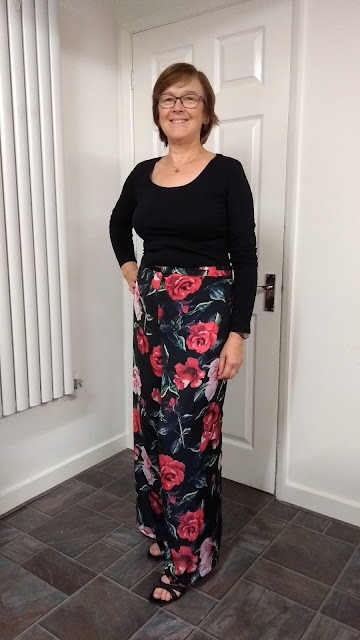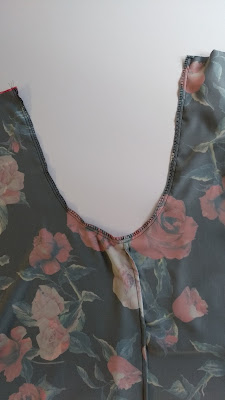I have now made three pencil skirts using Frances Tovin's pattern in the Maker's Atelier book. I have written about my first pink floral version here, you can see the black sparkly version here and the blue one is yet to be blogged.
This is proving to be such an easy, versatile jersey skirt pattern that I can see I will be making more. It is a great stash buster but also provides a good pattern to make a quick shirt to compliment the other things in my wardrobe.
I needed a new black pencil skirt for work. I have been wearing the same RTW skirt for years. I shortened it some time ago to keep up with modern fashions and it is now a bit tight and getting rather worn. I had already bought a length of black suiting and some lining to make a replacement but I decided instead to try the pencil skirt pattern hack. This line drawing shows exactly how the skirt is put together.
I bought a length of textured, black jersey in a medium weight. I was drawn to this fabric by its interesting textured surface. This has been difficult to photograph on such a dark fabric but hopefully the picture below gives you some idea of the texture.
The instructions for the pencil skirt hack were simple and easy to follow. Using the original pencil skirt pattern, Francis tells you to trim a 9cm strip off the side seam. I made another pattern in newspaper, moved the pattern over by 9cm all the way along and cut along the curved edge.
The side panels are each made from a rectangle 20 x 75cm.
I cut out the pattern pieces quickly and in no time at all I had made up my new skirt. Yippee!
I like the added interest of the princess seams on this plain fabric and I am glad that I tried this variation rather than just making another plain pencil skirt. The elasticated waist band is very comfortable to wear. I have generally found that a zigzag stitch is the best stitch to finish the elastic casing around the waist and a twin needle is better for the hem. I tested out each stitch on a fabric scrap before stitching the finished garment. The stretch fabric makes this narrow skirt easy to walk in, but it still has a flattering silhouette.
The side panels are each made from a rectangle 20 x 75cm.
I cut out the pattern pieces quickly and in no time at all I had made up my new skirt. Yippee!
I like the added interest of the princess seams on this plain fabric and I am glad that I tried this variation rather than just making another plain pencil skirt. The elasticated waist band is very comfortable to wear. I have generally found that a zigzag stitch is the best stitch to finish the elastic casing around the waist and a twin needle is better for the hem. I tested out each stitch on a fabric scrap before stitching the finished garment. The stretch fabric makes this narrow skirt easy to walk in, but it still has a flattering silhouette.
This skirt is a very useful addition to my wardrobe. It goes with lots of tops that I have already made so here are two more that I have tried.
 |
| Worn with my flutter sleeve blouse |
 |
| The back view paired with my long sleeved striped T-shirt |
 |
| Looking very pleased with myself wearing yesterday's T-shirt with today's quick skirt |
This pattern is so easy. It hasn't challenged me to learn new skills and it can't really be described as an interesting make. The secret of its success for me is that I can run up a skirt so quickly to suit any occasion. This black skirt is an understated, wardrobe basic but if I choose a beautiful fabric I can also make something more dramatic for a special occasion.
Do you have a pattern that you love and have made over and over again. Please leave a comment below and share your recommendations.
Do you have a pattern that you love and have made over and over again. Please leave a comment below and share your recommendations.
































